

Home | Spaceship Earth | Book Reviews | Buy a Book | Bean and Grain Index | Short Stories | Contact | Mud Blog
By Dan Armstrong
INTRODUCTION
The Food and Agriculture Organization of the United Nations called 2013 the year of quinoa. Referring to quinoa as a "climate-proof" crop, capable of adapting to a wide range of environments, the FAO is recommending quinoa as a high-protein staple crop to nations facing agricultural issues related to climate change or endemic food insecurity. Nations as varied in climatic conditions as Pakistan, Egypt, Denmark, England, and Australia are currently amid quinoa field trials to determine if quinoa can be grown in their region as a viable staple.
Pursuing the same line of reasoning as the FAO, the Southern Willamette Valley Bean and Grain Project, an ongoing effort to rebuild the western Oregon's food system through the increased production of organic, locally grown and locally consumed staple crops, has been exploring the potential of growing quinoa in western Oregon for several years. This paper describes recent Southern Willamette Valley Bean and Grain Project research aimed at evaluating quinoa as a commercial production crop in the Willamette Valley.
ABSTRACT
These field trials were designed to explore the earliest possible planting date for Chenopodium quinoa in the Willamette Valley for use as a commercial crop.
Chenopodium quinoa has been grown in the Willamette Valley for more than twenty years, but only for specialty seed production, never as a commerical food crop. There are several reasons for this, some related to the commercial market and some related to production problems.
The main production problems for growing quinoa as a staple in the Willamette Valley are (1) infestation by lygus bugs, which are prevalent in the Willamette Valley's commercial grass seed fields, and (2) quinoa's long life cycle, which is often in excess of 120 days depending on variety.
Lygus bugs become the most detrimental to Willamette Valley quinoa after the grass seed harvest in mid-July, when the lygus bugs migrate from the harvested grass seed fields to other plant varieties–Chenopodium quinoa being one target.
Quinoa's long life cycle in the somewhat truncated Willamette Valley growing season can make harvest problematic. Quinoa planted April 15 (the generally accepted best planting date for quinoa in the Willamette Valley) results in a harvest date somewhere between August 15 and September 15. Increased moisture in the air after September 1, creating heavier mornng dew and a greater likelihood of rain, can cause mold in quinoa seed heads and/or compromise seed left in the field to dry.
A third, though lesser, concern for quinoa grown in the Willamette Valley is high ambient temperatures. Quinoa pollen viability has been found to decrease when ambient air temperatures exceed 94 degrees Fahrenheit. In the Willamette Valley, temperatures generally do not exceed 94 degrees Fahrenheit until after mid-July and increase in likelihood with each day afterward through the end of August.
Finding a shorter-term quinoa and/or one that can be planted earlier and also be harvested earlier could conceivably avoid the lygus bug migration after mid-July, the higher ambient temperatures of late July and August, and the air moisture increases of September. These field trials were designed with these issues in mind.
MATERIALS AND METHODS
The field trails were conducted in Eugene, Oregon at the south end of the Willamette Valley. The test plot soil quality was moderate to marginal. A mixture of liquid fish fertilizer and kelp was applied to the plants twice, once in May and once in June. No other fertilization inputs, herbicides, or pesticides were used. Plants were irrigated sparingly from mid-June to August 20.
The 2013-14 field trials ran from October 2013 through September 2014. Six varieties of quinoa–local seed produced through six generations of quinoa in Eugene, Frank Morton's Cherry Vanilla, Frank Morton's French Vanilla, a Chadmo variety from the island of Chloe in Chile (which will be referred to as Chadmo Original through the rest of this paper), PI 614880, and PI 634919–were planted at the middle of each month October through April. The mid-May planting added Frank Morton's Brightest Brilliant Rainbow to the original six. The earliest planted survivor came from the Chadmo Original seed planted on March 15, 2014. Only one of those plants survived to produce seed. All varieties planted in mid-April and mid-May of 2014 survived and produced seed. (See final report for 2014.)
The 2014-15 field trials ran from September 2014 to September 2015. Six rows of six varieties of quinoa were planted on September 16 and October 10 of 2014. The six varieties were PI 510533, PI 510547, PI 614880, PI 634919, Chadmo Original, and Philomath, Oregon seed breeder Frank Morton's Brightest Brilliant Rainbow.
Six rows of seed were also planted on February 17, March 7, March 26, and April 21 of 2015. The plots were planted with PI 510533, PI 510547, F1 seed harvested from the March 2014 Chadmo Original, F1 seed harvested from April 2014 PI 634919, Chadmo Original, and Frank Morton's Brightest Brilliant Rainbow.
Additionally, F1 seed harvested from a purple variety of April 2014 Chadmo Original was planted on April 22, 2015, and F1 seed harvested from the March 2014 Chadmo Original was planted on May 10, 2015.
It should be noted that the winter of 2014-15 was a complete reversal from that of 2013-14. The 2013-2014 winter was one of the coldest in recent memory in the Willamette Valley. Two snowfalls in excess of ten inches and long spells of temperatures in the low twenties, occasionally falling to single digits, marked the year. The 2014-15 winter was one of the mildest in recent history. Though freezing temperatures occurred, there was no snow and 20 degrees Fahrenheit was the lowest recorded temperature. The summers of 2014 and 2015 were both very hot and dry, but 2015 was unusually so. The average rainfall for the area for the months April through August is 8.2 inches. In 2014, those months totaled 5.2 inches of rain. In 2015, that total was 2.1 inches, with less than an inch from mid-April to August 31. At the same time, ambient air temperatures frequently broke 90 degrees Fahrenheit from the first week of June through August.
OBSERVATIONS AND RESULTS
September 16 Planting: Though September was warm with several days in the low 80s, germination was sporadic for all six quinoa varieties. Often sprouts would appear and be gone in a day or two. Fearing the sprouts were being eaten by birds, a frame covered with bird-netting was used to protect the sprouts. While the seeds continued to germinate sporadically, most sprouts disappeared within a few days even with the protective netting, suggesting something other than birds were eating them. Only three seedlings (one PI 510533 and two PI 510547) made it past October 10. These plants grew very slowly for another month, reaching two inches in height by November 1. The weather then turned cold with rain and temperatures below freezing. The three seedlings were dead by November 17.
October 10 Planting: Even with the slight cooling of October, germination occurred in all six rows of the October plot, but by November 1, only four of the rows had maturing seedlings, with the PI 614880 seedling doing the best. When the colder weather arrived in the second week of November, all of the plants in the October plot were dead by November 17.
February 17 Planting: The weather from February 17 to March 7 was quite cold. Temperatures reached freezing half of the nights, with lows of 27 degrees Fahrenheit on February 24 and March 1 and a low of 26 degrees Fahrenheit on March 3. Even with these cold temperatures, germination occurred in four of the six varieties. After March 7, the temperatures began to moderate. Two PI 510547 seedlings, eight F1 March 2014 Chadmo Original seedlings, six F1 April 2014 PI 634919 seedlings, and four Chadmo Original seedlings were still present in the February plot on March 10. See images below.
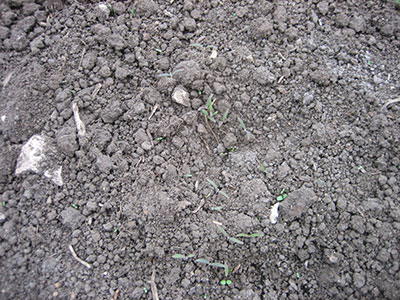
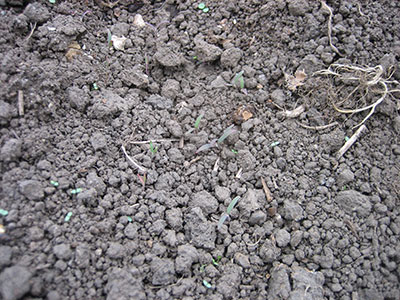
The second set of leaves had appeared on several of these seedlings by March 16. All twenty plants in February plot showed four sets of leaves by March 25. April 2015 was unusually dry and mild for the Willamette Valley. The night time lows were between 34 and 44 degrees Fahrenheit and the highs were in the 60s, occasionally the low 70s, often with clear skies. No rain fell from April 15 to May 15. All twenty plants in the February plot continued to mature and look healthy. Deer entered the test plot location on May 16. Four of the February plants were topped by the deer, but none were completely eaten and all survived to harvest. Seed heads began to form on May 20. Harvest dates for the plants varied from July 19 to August 10, with the majority of seed harvested by July 27. See mature plants and harvested seed heads below.
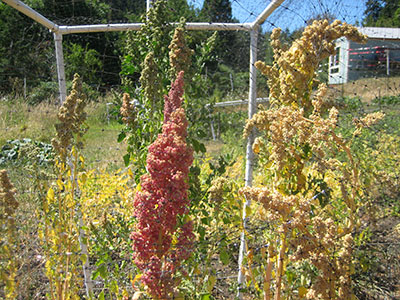
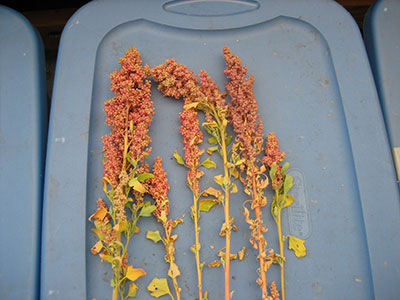
March 7 Planting: Germination occurred in the rows containing PI 510547, F1 March 2014 Chadmo Original, and F1 April 2014 PI 634919 on March 16. Five weeks later, April 21, only one F1 March 2014 Chadmo Original seedling and one F1 April 2014 PI 634919 seedling were still standing. On May 16, deer topped the F1 April 2014 PI 634919 plant. It survived , but produced negligible seed. The F1 March 2014 Chadmo Original was the only plant to produce seed in the March 7 plot. It was harvested on August 10. See early and late photos below.

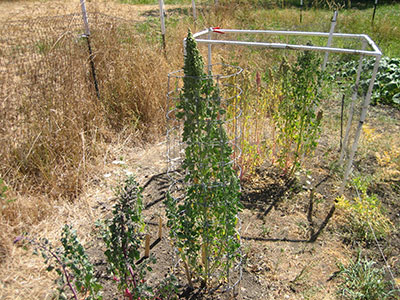
March 26 Planting: Several of the F1 April 2014 PI 634919 seeds germinated one week after planting. Only one other variety, F1 March 2014 Chadmo Original, germinated. Though the weather remained mild through April (lows in the 30s and 40s, daytime temperatures in the 60s), only one seedling survived to May 1. It grew into a healthy, mature plant and was harvested on August 26.
April 21 Planting: A high percentage of the seed in all six rows germinated by May 15. Five of six varieties survived to produced seed. Only PI 510533 did not create a mature seed head. For some reason, the variety grew to a height of 18 inches, then stopped growing. Generally the PI 510533 variety did very poorly in every planting, rarely even germinating. The photo below shows the PI 510533 plants (with small lavender panicles) in July and August of 2015.
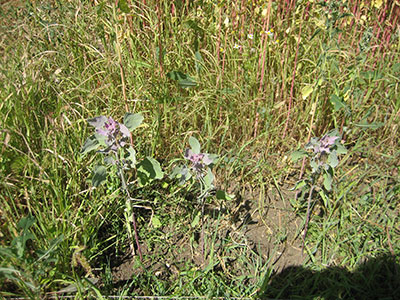
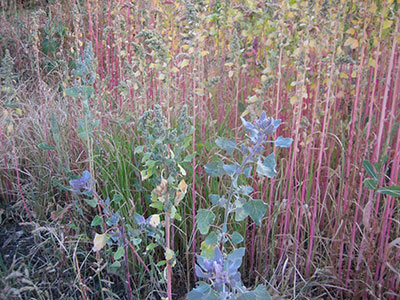
April 22 Planting: This plot was planted with ten seeds from only one variety. The seed came from a purple F1 April 2014 Chadmo Original. Though six seeds germinated, only two plants survived, both stunted and with little to no yield.
May 10 Planting: This planting again included only one variety, F1 March 2014 Chadmo Original. Six rows were planted. Almost all seed germinated, and almost all the plants survived to harvest on September 8; however, the heads had very little seed. See photos below from August 10.

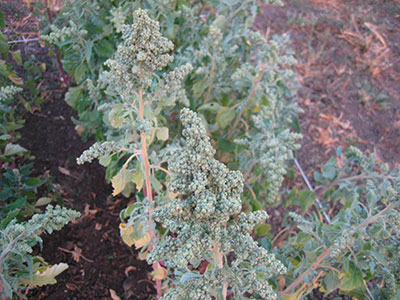
Survival Summary and Harvest Dates: There were no survivors from the September and October plantings. Seed was harvested from at least one variety from the February 17, March 7, March 26, April 21, April 22, and May 10 plantings. See planting and harvest summary below.
| Planting Date | Variety | Seeds planted/harvested | Harvest Date | Life Cycle |
|---|---|---|---|---|
| February 17 | PI 510547 | 20/2 | July 27 | 160 days |
| February 17 | Chadmo O. F1 | 50/8 | 7/19; 7/24; 7/27; 8/10 | 152-174 days |
| February 17 | PI 634919 F1 | 50/6 | 7/19; 7/27 | 152-160 days |
| February 17 | Chadmo O. | 60/4 | 7/19; 7/24 | 152-157 days |
| March 7 | Chadmo O. F1 | 30/25 | August 10 | 156 days |
| March 26 | PI 634919 F1 | 50/1 | August 20 | 147 days |
| April 21 | PI 510547 | 20/14 | August 26 | 127 days |
| April 21 | Chadmo O. F1 | 90/50 | August 11 | 112 days |
| April 21 | PI 634919 F1 | 35/25 | August 26 | 127 days |
| April 21 | Chadmo O. | 90/55 | August 26 | 127 days |
| April 21 | Br. Brilliant | 50/10 | August 26 | 127 days |
| May 10 | Chadmo O. F1 | 180/100 | September 8 | 91 days |
Birds: The 2013-14 field trials were plagued by a flock of titbush. All of the plants had to be caged with bird-netting. Birds were not a problem in the 2014-15. Bird-netting was never used, except for protection from deer.
Deer: Deer had never gotten over the fence around the field trial plots in its seven years of existence. The 2015 summer saw the first deer incursion, and it continued even after raising the fencing to eight-feet. It was likely the extreme dryness of the summer that caused the deer to venture into places they had never gone before.
Curly Leaf: Curling leaves were see in at least 5% of the quinoa plants in 2013-14. None was seen in 2014-15.
Chenopodium Album: Chenopodium album was a huge problem in 2013-14, and it remained that way in 2014-15. More experience with it made management somewhat easier.
Ambient Temperature: The summer of 2014 was hot, but the summer of 2015 was record-breaking. More than 25 days between June 1 and August 31 reached 90 degrees Fahrenheit or higher. The graphs below show a temperature comparison for the summers of 2014 and 2015. Note that temperatures began to break 90 degrees Fahrenheit in the first week of July in 2014 and remained high through September. Temperatures reached 90 degrees Fahrenheit during the first week of June in 2015 and continued periodically through the first week of September.
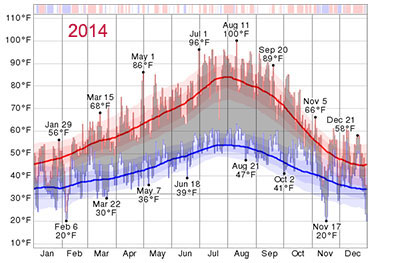
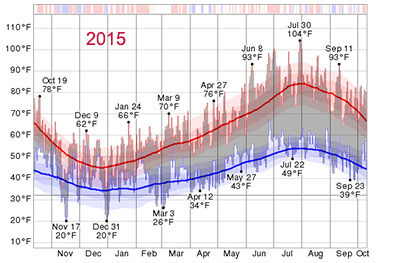
DISCUSSION
The field trials were remarkable because of the survival and harvest of 20 quinoa plants from the February 17 planting. Four plants of three varieties were harvested on July 19; eight plants of two varieties were harvested on July 24, 7 plants of three varieties were harvested on July 27, and one plant was harvested on August 10. The unusually warm winter, particularly the very mild second half of March, was the most likely reason for this success. It is fair to say these results were an anomaly and cannot be expected on a regular basis; however, the two weeks following planting–February 17 to March 7–were extremely cold with three nights below 28 degrees Fahrenheit, and served to prove quinoa's capacity to germinate in ground under 40 degrees Fahrenheit.
Considering the success of the February 17 planting, it is difficult to explain why only one plant from the March 7 planting and one from the March 26 planting made it to harvest. Even with this said, the March 7 survivor should be considered exceptional.
For the second straight year, germination rates and plant success rates went from very low for plantings prior to April to over fifty percent after the second week in April, verifying mid-April as the optimum planting date.
None of the September and October plantings reached harvest, but the two plantings revealed a cold temperature limit for young quinoa plants. Many of the seedlings reached a height of several inches, showing as many as twelve leaves, but when the ambient temperature fell to 20 degrees Fahrenheit the night of November 17, all the plants died.
As in the first set of field trials, the length of the quinoa life cyce shortened with the later plantings, reaching a high of 174 days for one plant planted February 17 and dropping to a low of 91 days for the May 10 planting. Generally speaking, however, a plant planted thirty days before another does not gain thirty days of life cycle. The trade off is not quite one day for one day. For example, the F1 March 2014 Chadmo planted on February 17 and harvested July 19 had a life cycle of 152 days. The F1 March 2014 Chadmo planted on May 10 and harvested on September 8 had a life cyle of 91 days. The planting dates differered by 82 days, but the harvest dates only differed by 61 days.
Lygus bugs were not the problem they had been in the previous field trials or to other quinoa growers in the Willamette Valley. Proximity to large commercial grass seed farms does play a part in lygus bug access to quinoa, but the lack of rain through the summer may also have affected the lygus bug population valley-wide.
Deer were a problem, possibly because of the dry weather, but they seemed to lose interest in the quinoa after the seed head matured, probably because of the saponin seed coating.
Despite the high July temperatures, only the May 10 planted F1 March 2014 Chadmo Original had dramatically poor seed production.
SUMMARY
The success of the F1 March 2014 Chadmo Original seed and the F1 April 2014 PI 634919 seed in the trials suggests considerable adaptation in a single year. The mild second half of March certainly played a big part in the February 17 planting's success, but plant adaptation also seemed to contribute. To the question of growing Chenopodium quinoa in the Willamette Valley as a commerical staple crop, the answer appears to be "yes" with a few qualifiers. More work with seed adaptation is necessary. The location of the plot should not be near large commerical grass seed operations, and deer and birds must both be anticipated and/or contended with. (It should be noted that a farmer at the north end of the valley harvested 50,000 pounds of quinoa in August of 2015 from a forty acre plot. This was the most acres ever devoted to quinoa by a single grower in the Willamette Valley, and also the largest harvest.)
ACKNOWLEDGMENTS
This project would not have been possible without the much appreciated intellectual and material support from David Brenner at the Plant Introduction Center at Iowa State University, Daniel Bertero at Universidad de Buenos Aires, and Kevin Murphy at Washington State University. A conversation with Daniel Bertero at the 2013 Quinoa Conference in Pullman Washington inspired this research project. Special thanks to Daniel.